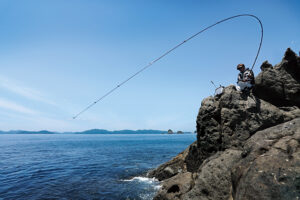Vintage Pattern of Tenkara Fly
This is except from a Japanese book about traditional river fishing. Original name of the book is shown at the end of this article. This book explores the tradition of river fishing (commercial fishing as well as angling.) It shows a lot about the intericate interaction between men and rivers. Among these interesting contents, please let me introduce you about a traditional tenkara fly pattern.
Vintage Matched Flies
From its beginning, fly tying is a crucial part of tenkara. Most of tenkara anglers has been tying their tenkara flies, using feathers from hunted birds, such as Copper pheasant and Green pheasant. There were people who had Japanese bantam and chicken to get feathers whenever he wanted.
With this tradition of fly tying, each angler had invented their own patterns. Further on, each had their favorites, and it was natural for a certain region to have some of the favorites. Such a favorite fly is called Atari-bari (Literal translation is “hitting-hook”, Matched fly.)
Such favorite flies were often made by convergence of various types or patterns. Each region or river had its own matched fly, and it had been transferred to next generations. The meaning of matching is not matching with particular baits, but matching with regional patterns.
In the book, the author explains about a matched fly of Nakazato region of Yuzawa town, upper part of Uono river. This fly was introduced by a man who was born there, in 1941.
When this man was a boy, an old experienced angler had told him about this fly. Then as he grew up, he applied improvement to suit fishing styles there.
Materials
The main material is a yellow feather of male Japanese bantam. The feather is called Kihada-Shinkuro, a yellow feather with black color near the shaft. The feather of this color is taken from a specially bred individual bantam, mixing Japanese bantam and a kind of chicken.
This feather is soft enough for fish to get swallowed easily. With it, hooking is done by the fish itself. It is said that this yellow feather worked well in the day as well as morning or evening.
Hook selection
The hook is called Maruseigo shape (twisted), no.12, gold.
Eye of the hook is made with a nylon monofilament line of 0.28 mm. (Note; Japanese hooks do not have eyes.) This monofilament line loop is bundled together with the shank, with the thread of silk. Silk thread is used because it becomes strong when it gets wet, and with soaked water, the total weight of the fly becomes heavier, which makes the casting easier. Threading is done only to the middle of the shank, down to the height of the hook point. It makes the half of the shank bare. To wrap its hackle, it needs attention that the outside of the hackle faces outwards. And as a final step, securing the hackle with silk thread.
The reasons for this selection of round hook are that this shape is much stronger than other shapes used for tenkara, and that the hooking is better and suitable for this area's fishing.
According to this man’s explanation, the combination of this Maruseigo and half-way-up threading makes hooking better. When a char bites, the bare part of the hook slips in its mouth and the hook turns smoothly to make a better hooking.
In other areas, different shapes of hooks are selected. Popular shapes are Kitsune or Sode shape. These have longer shanks, and are preferred for longer threading areas in the hook. You can see that these hooks are more straight, and the vintage pattern here has rounded hooks.
The pattern is very simple. This simplicity goes very well with the spirit of tenkara.
With the rich nature, such patterns had been proven, and handed down to following generations. We are happy to share such heritage with the current anglers.
Image of Nakazato, Yuzawa Town, from this link.
Book information
川漁;越後魚野川の伝統漁と釣り、戸門 秀雄(農山漁村文化協会、2021年) “Kawaryo,” Hideo Tokado, 2021

